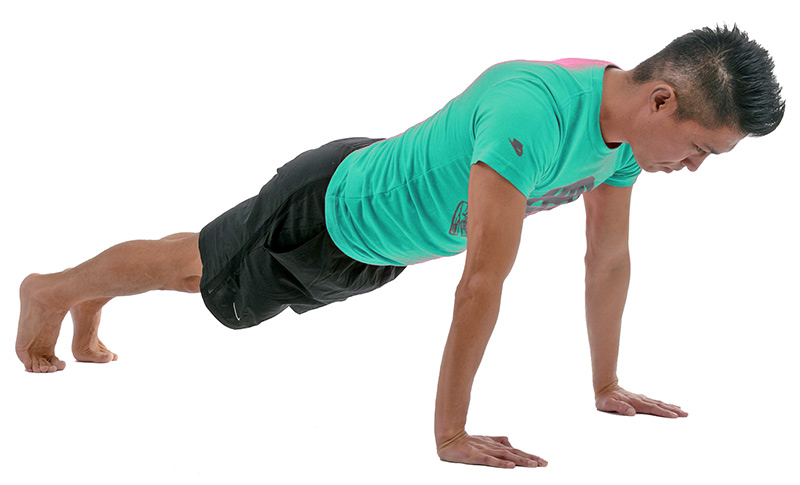Push-Up Fitness Test Instructions
The push-up (or press-up) test measures muscular endurance of the upper body (anterior deltoid, pectorals major, and triceps muscles).
Requirements
You will need a clear flat surface such as a gymnasium floor, plus a stopwatch for timing. You will also need an assistant to monitor the correct technique and record the results.

Procedure
- Perform a warm-up and practice the required technique.
- The starting 'up' position is with the hands placed shoulder width apart with fingers pointing forward and feet together on a
level surface. The arms are fully extended with only hands and feet touching the
ground.
- Lower your body to the floor until your arms are bent at right angles. Keep your back straight at all times.
- Return to the up position with your arms fully extended. This is one repetition.
- Resting is permitted only in the 'up' position.
- Repeat the action for one minute.
- The total number of push-ups in one minute is recorded as the score. Any incorrectly performed push-ups are not counted.
- Compare the results to the norms below.
Video Example
Notes
This is just an example test protocol of a push up test. There are many ways you can perform a push up test. This test is based on the maximum number of push-ups you can do in one minute. Other tests may require you to do as many as you can in a different time period (e.g. 2 minutes) or as many as you can following a set tempo. Push-up fitness tests for women are often performed with the knees on the ground instead of the feet.
What is a Good Score?
You should be aiming for at least 20 push-ups in one minute. A result above 40 is very good. Here are some norms for the 1-minute push-up test.
Push-up test norms for men
| Age | 17-19 | 20-29 | 30-39 | 40-49 | 50-59 | 60-65 |
| Excellent | > 56 | > 47 | > 41 | > 34 | > 31 | > 30 |
| Good | 47-56 | 39-47 | 34-41 | 28-34 | 25-31 | 24-30 |
| Above average | 35-46 | 30-39 | 25-33 | 21-28 | 18-24 | 17-23 |
| Average | 19-34 | 17-29 | 13-24 | 11-20 | 9-17 | 6-16 |
| Below average | 11-18 | 10-16 | 8-12 | 6-10 | 5-8 | 3-5 |
| Poor | 4-10 | 4-9 | 2-7 | 1-5 | 1-4 | 1-2 |
| Very Poor | < 4 | < 4 | < 2 | 0 | 0 | 0 |
Push-up test norms for women
| Age | 17-19 | 20-29 | 30-39 | 40-49 | 50-59 | 60-65 |
| Excellent | > 30 | > 32 | > 28 | > 20 | > 16 | > 12 |
| Good | 22-30 | 24-32 | 21-28 | 15-20 | 13-16 | 10-12 |
| Above Average | 11-21 | 14-23 | 13-20 | 10-14 | 9-12 | 6-9 |
| Average | 7-10 | 9-13 | 7-12 | 5-9 | 4-8 | 3-5 |
| Below average | 4-6 | 5-8 | 3-6 | 2-4 | 2-3 | 2 |
| Poor | 1-3 | 1-4 | 1-2 | 1 | 1 | 1 |
| Very Poor | 0 | 0 | 0 | 0 | 0 | 0 |
Push-Up Test Variations
- Vary the time: This test is based on the maximum number of push-ups you can do in one minute. Other tests may require you to do as many as you can over a different time period, such as 30 seconds or 2 minutes.
- Follow a set tempo: some push-up fitness tests require the participant to perform them in time to a regular tempo, such as one every two seconds, for as long as possible.
- Vary the technique: some push-up fitness tests require the chest to touch the floor or some other object. The distance between the hands may also be different in some tests.
More Information
see other fitness test protocols
